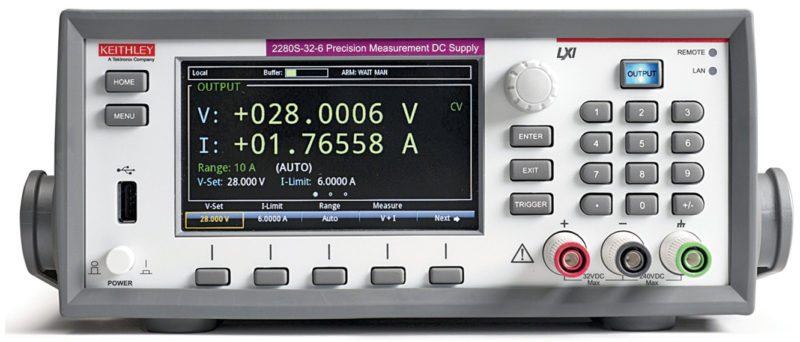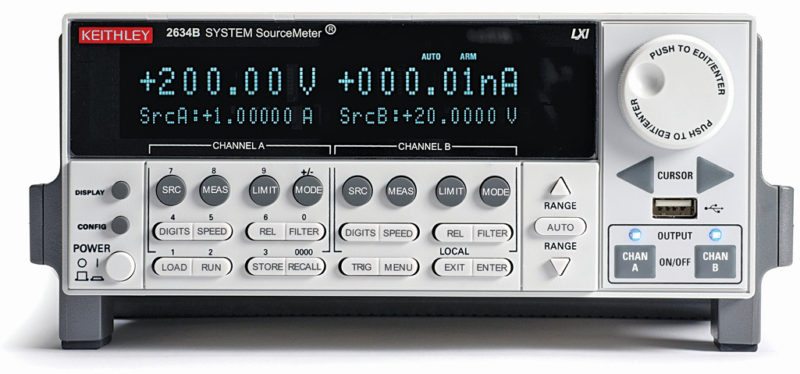In case of power supplies, the move from a wall outlet to a benchtop might not be a significant development when we have scientists working on wireless transmission of electricity. However, the move to portable power supplies has seen some interesting trends of its own. A lot of focus is being laid on the supplies to be operable in constant current, constant voltage, constant resistance, constant power and constant impedance modes.
Advances have also been in the fields of current measurement with nano-amp resolution, variable rise and fall times, digital input-output, multiple PC interfaces, battery-simulating capabilities and kilovolt outputs.
Raghunath Rao K., manager application team, Tektronix India Pvt Ltd, says his company is focusing on minimising power consumption to increase battery life for battery simulators. He explains, “You need a source measure unit with low current-measurement sensitivity to evaluate and qualify these devices for your design.” The source measurement unit can test a device over the voltage range of the battery.
Sumit Sharma, marketing manager, Good Will Instrument Co. India, says, “One particular requirement of power consumption for portable wireless communications devices is pulse current.” Pulse current measurement indicates transient current consumption, which helps in allocation of the power supply system for a product’s preliminary design, that is, power supply circuits and battery selection for client’s product analysis.

Today, the power supply industry is at the beginning of a major focus shift that puts efficiency improvements across the entire load range at the forefront of customers’ performance requirements. “Newer supplies offer resolutions as low as 1mA and 1mV,” adds Praveen Kumar Gupta, director, Avante Global Services Pvt Ltd. “Power supplies with the ability to measure very low currents,” says Rao, when asked about development areas.
PPH-1503 from GW Instek provides 0.1mA (equivalent to 4⅘ digits) current resolution under 5A setting. “It is capable of rise-time of 0.15 minutes and fall-time of 0.65 minutes,” says Sharma.
Multiple channel output. A common trend has been to increase the number of output channels. Though the most common type of supply remains the two-channel, we also have multiple channels coming in. MDL series from B&K Precision is one such example. The series offers support for up to four modules or eight channels, with the number increasing to up to eight modules or 16 channels with mainframe extension.
Similar trends are seen in other cases as well. The 382270 quad-output DC power supply from Extech has two 0 – 30V at 0 – 5A outputs plus two fixed auxiliary outputs of 3V – 6.5V at 3A and 15V at 1A, taking the technical output count to six channels.
Global Specialties has launched the 1415 dual-output DC power supply. It features up to 30V at 3A with dual independent outputs, wherein one fixed output produces 5V at 3A. Load condition changes with automatic crossover between constant current and constant voltage modes. Separate three-digit displays for voltage and current, with individual control of voltage and current, are some interesting features in 1415.
Programmable supply with USB connectivity. May be due to the Internet of Things (IoT) coming into the picture, or some other reason, everybody wants to control these devices from their computers. The programmable feature allows remote control of their operation through an analogue input or digital interface. “The latest versions have various interfaces like LAN and RS232,” says Gupta. Applications include automated equipment testing, crystal growth monitoring, semiconductor fabrication and X-ray generation. 1350 DC power supply from Global Specialties features programmable control via USB interface and microprocessor-controlled circuits.
National Instruments PXI-4110 is a programmable, triple-output precision DC power supply in a single slot with three analogue channels in PXI module. It has 16-bit resolution for programming the voltage set point and current limit.
In case of the Z+ series from TDK Lambda, connectivity options include built-in USB, RS232 and RS485 interfaces, along with LAN, GPIB and isolated analogue interfaces. Z+ is light as well; you can move the power supply around without hitting the gym.

Not a feather but still light. Benchtop equipment are generally heavier than other types, which requires moving the test setup to the supply every time. However, Gupta says, “The devices are becoming smaller and more energy-efficient.” REOLINE range of portable power supplies provides an adjustable low-loss output voltage, in addition to being lightweight. The lightweight equipment are certainly more portable. These might not be as portable as handheld equipment but the move has certainly begun.

A case in point would be the benchtop PSU 130 from Jameco Electronics. This single-channel supply is a compact little device weighing about 500gm. With two digital four-digit displays, it measures less than 15.2cm (6-inch). It also features short-circuit and overload protection.
Safety in equipment. One of the sure-fire ways to damage a power supply is to overload it. Excess current heats up the components, which eventually fail. Components ranging from transistors and diodes to resistors and capacitors could easily burn out on overload. This calls for some safety features to be built into the device.
Among the various power supplies in power supplies released recently would be REOLINE range of portable power supplies from REO UK Ltd. It features step-less adjustment of voltage from absolute zero to maximum output. Safety features include operation under high inrush currents as well as ability to withstand sustained overloads, without a detrimental impact on overall performance. “Research labs and test departments simply cannot operate effectively without variable voltage,” says Steve Hughes, managing director, REO UK.
Safety features in Genesys series from TDK Lambda include a safe start, which returns the power supply to its last setting configuration post power interruption. Other features include over-voltage protection, under-voltage limit, fold-back protection and over-temperature protection.
Supplying the required power. “Power supplies are going to stay as tools for product design, testing, QA, production as well as service applications,” says Gupta. If recent advances are any indication, it seems all uphill from here.
Rao says, “In the future, users will require multiple-channel versions of these supplies to address banks of batteries.” He adds, “Battery simulators will incorporate more sophisticated models to simulate battery performance.”
With computer connectivity through LAN and RS232, these power supplies have made operation easier as these save time and hassle. According to Siglent, USB, LAN and other interfaces will become standard functions in power supplies. The circuit design of power supplies should be optimised to achieve better dynamic performance.
If innovations keep happening at this pace, we will probably have some more interesting features in the near future.
Saurabh Durgapal is working as technology journalist at EFY








